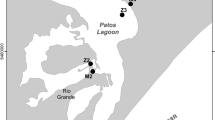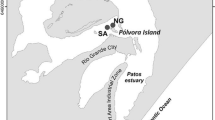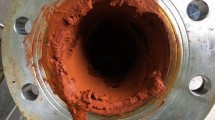Abstract
The distribution of arsenic (As(III), As(V)) and iron (Fe(II), Fe(III)) species was monitored during 1 year in a borehole drilled in the Carnoulès tailings impoundment which contains As-rich pyrite. The concentrations of total As and Fe in subsurface waters exhibited strong variations over one year, which were controlled by dissolved oxygen concentrations. At high oxygen levels, extremely high As (up to 162 mM) and Fe (up to 364 mM) concentrations were reached in the borehole, with the oxidised species predominant. As and Fe concentrations decreased 10-fold under oxygen-deficient conditions, as a result of pH increase and subsequent precipitation of As(V) and Fe(III). From drill core sections, it appeared that at low dissolved oxygen levels, As(III) was primarily released into water by the oxidation of As-rich pyrite in the unsaturated zone. Subsequent As and Fe precipitation was promoted during transport to the saturated zone; this reaction resulted in As enrichments in the sediment below the water table compared to the original content in pyrite, together with the formation of As-rich (up to 35 wt% As) ferruginous material in the unsaturated zone. High amounts of As(V) were released from these secondary phases during leaching experiments with oxygenated acid sulfate-rich waters; this process is believed to contribute to As(V) enrichment in the subsurface waters of the Carnoulès tailings during periods of high dissolved oxygen level.
Similar content being viewed by others
References
Alkaaby A., Leblanc M.and Perissol M.(1985)Mine ´ralisation diage ´ne ´tique pre ´coce (Pb —Zn –Ba)dans un environnement de ´tritique continental:cas tu Trias de Carnoule's (Gard.France).C.R.Acad.Sci., Paris 300,919–922.
Bigham J.M., Schwertmann U., Traina S.J., Winland R.L.and Wolf M.(1996)Schwert-mannite and the chemical modeling of iron in acid sulfate waters.Geochim.Cosmochim. Acta 60 (12),2111–2121.
Bohari Y, Astruc A., Astruc M.and Cloud J.(2001)Improvements of hydride generation for the speciation of arsenic in natural freshwater samples by HPLC –HG –AFS.J.Anal.At. Spectrom 16,774–778.
Bostick B.C.and Fendorf S.(2003)Arsenite sorption on troilite (FeS)and pyrite (FeS2 ), Geochim.Cosmochim.Acta 67 (5),909–921.
Carlson L., Bigham J.M., Schwertmann U., Kyek A.and Wagner F.(2002)Scavenging of As from acid mine drainage by schwertmannite and ferrihydrite:A comparison with synthetic analogues Environ.Sci.Technol.36,1712–1719.
Chukhlantsev V.G.(1956)The solubility products of a number of arsenates.J.Anal.Chem. (USSR)11,565–571.
Courtin-Nomade A., Bril H., Neel C.and Lenain J.F.(2003)Arsenic in iron cements developed within tailings of a former metalliferous mine —Enguiale's,Aveyron,France. Appl.Geochem.18,395–408.
Dove P.M.and Rimstidt, J.D.(1987)Solubility and stability of scorodite,FeAsO4 –2H2 O: Reply.Am.Mineral. 72 (1/2),845–848.
Foster A.L., Brown Jr. G.E., Parks G.A.and Tingle T.N.(1998)Quantitative speciation of arsenic in mine tailings using X-ray absorption spectroscopy Am.Mineral. 89,553–568.
Fuller C.C., Davis J.A.and Waychunas G.A.(1993)Surface chemistry of ferrihydrite —Part 2,kinetics of arsenate adsorption and coprecipitation.Geochim.Cosmochim.Acta 57, 2271–2282.
Juillot F., Ildefonse P., Morin G., Calas G., De Kersabiec A.M.and Benedetti M.(1999) Remobilization of arsenic from buried wastes at an industrial site:Mineralogical and geochemical control.Appl.Geochem.14,1031–1048.
Ko. K., Leblanc M., Jourde H., Casiot C., Pistre S., Gouze P.and Elbaz-Poulichet F.(2003) Reverse oxidation zoning in mine tailings generating arsenic-rich acidic waters (Carnoule's, France).J.Int.Mine Water Assoc.22,7–14.
Krause E.and Ettel V.A.(1989)Solubilities and stabilities of ferric arsenate compounds, Hydrometallurgy 22,311–337.
Langmuir D.(1997)Acid mine waters.In Aqueous Environmental Geochemistry,(ed.R. McConnin),pp.457–478.Prentice-Hall,Inc., New Jersey.
Langmuir D., Mahoney J., MacDonald A.and Rowson J.(1999)Predicting arsenic con-centrations in the porewaters of buried uranium mill tailings.Geochim. Cosmochim.Acta 63 (19/20),3379–3394.
Leblanc M., Achard B., Ben Othman D.and Luck J.M.(1996)Accumulation of arsenic from acidic mine waters by ferruginous bacterial accretions (stromatolites).Appl.Geochem.11, 541–554.
Leblanc M., Casiot C., Elbaz-Poulichet F.and Personne ´ J.C.(2002)Arsenic removal by oxidizing bacteria in a heavily arsenic-contaminated acid mine drainage system (Carnoule's,France).Mine Water Hydrogeology and Geochemistry,Geological Society (eds.P.L. Younger,and N.S.Robins),Vol.198,pp.267–274.Special Publications, London.
McCreadie H., Blowes, D.W., Ptacek C.J.and Jambor J.L.(2000)In. uence of reduction reactions and solid-phase composition on porewater concentrations of arsenic.Environ. Sci.Technol.34,3159–3166.
Nordstrom D.K.and Alpers C.N.(1999)Negative pH,e. orescent mineralogy,and con-sequences for environmental restoration at the Iron Mountain Superfund Site,California. Proc.Nat.Acad.Sci.,USA 96,3455–3462.
Raven K.P., Jain A.and Loeppert R.H.(1998)Arsenite and arsenate adsorption on ferrihy-drite:Kinetics,equilibrium,and adsorption envelopes,Environ.Sci.Technol.32,344–349.
Rodier J., Broutin J.P., Chambon P., Champsaur H.and Rodi L.(1996).L' analyse de l' eau. Dunod, Paris,pp.1383.
Roussel C., Bril H.and Fernandez A.(1999)Evolution of sulphides-rich mine tailings and immobilization of As and Fe.C.R.Acad.Sci. 329,787–794.
Savage K.S., Tingle T.N., O'Day P.A., Waychunas G.A.and Bird D.K.(2000)Arsenic speciation in pyrite and secondary weathering phases,Mother Lode District,Tuolumne County, California.App.Geochem. 15,1219–1244.
Vircikova E., Molnar L., Lech P.and Reitznerova E.(1995)Solubilities of amorphous Fe –As precipitates.Hydrometallurgy 38,111–123.
Zobrist J., Dowdle P.R., Davis J.A.and Oremland R.S.(2000)Mobilization of arsenite by dissimilatory reduction of adsorbed arsenate.Environ.Sci.Technol. 34,4747–4753.
Author information
Authors and Affiliations
Rights and permissions
About this article
Cite this article
Casiot, C., Leblanc, M., Bruneel, O. et al. Geochemical Processes Controlling the Formation of As-Rich Waters Within a Tailings Impoundment (Carnoulès, France). Aquatic Geochemistry 9, 273–290 (2003). https://doi.org/10.1023/B:AQUA.0000028985.07557.39
Issue Date:
DOI: https://doi.org/10.1023/B:AQUA.0000028985.07557.39




